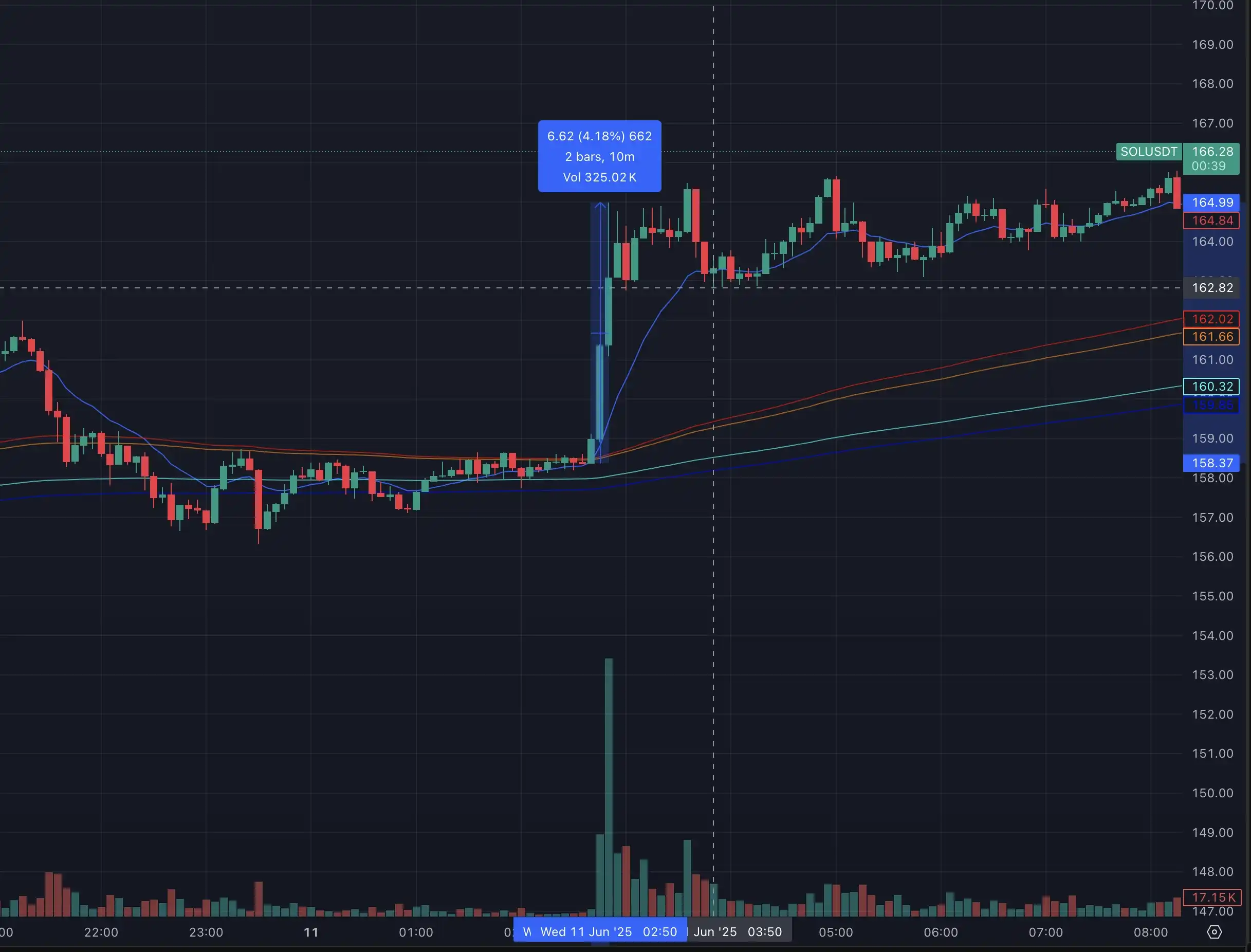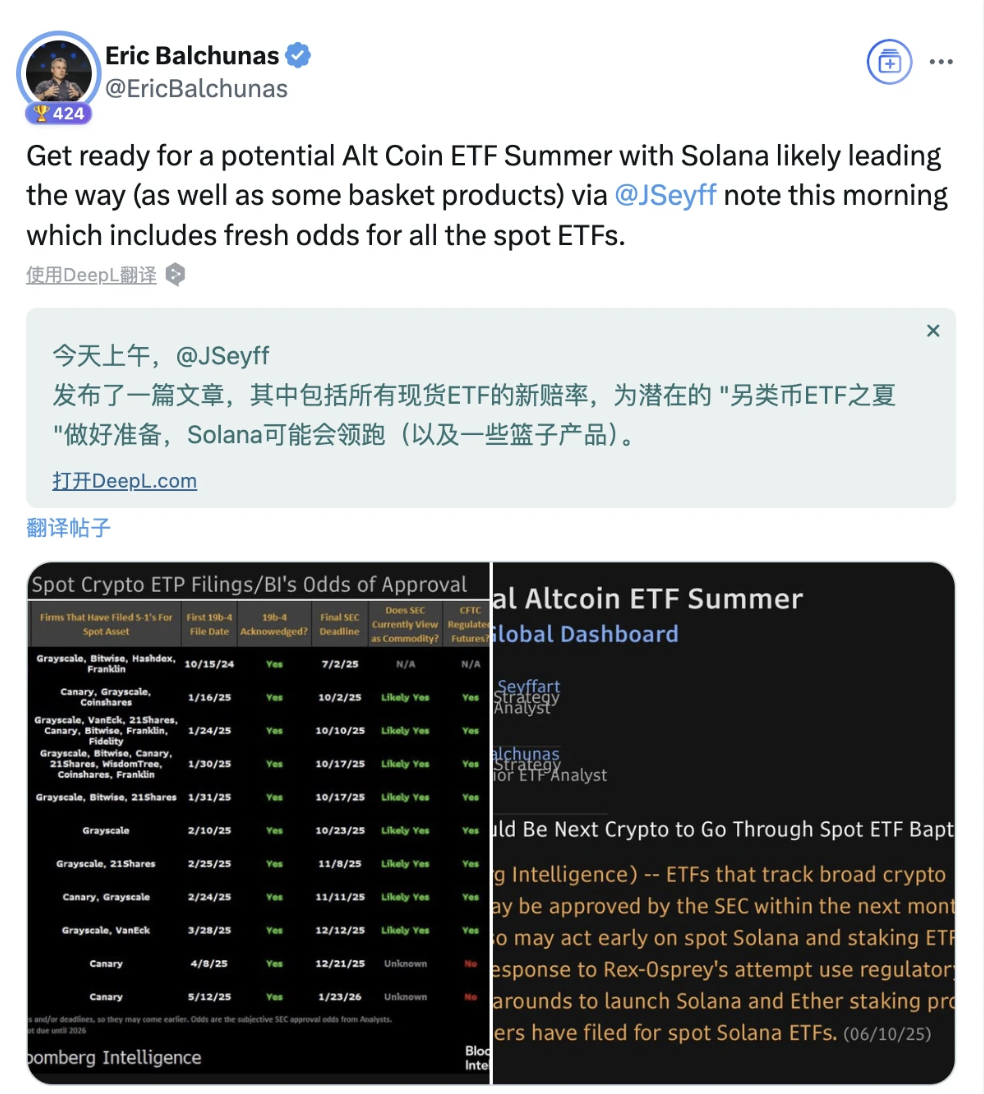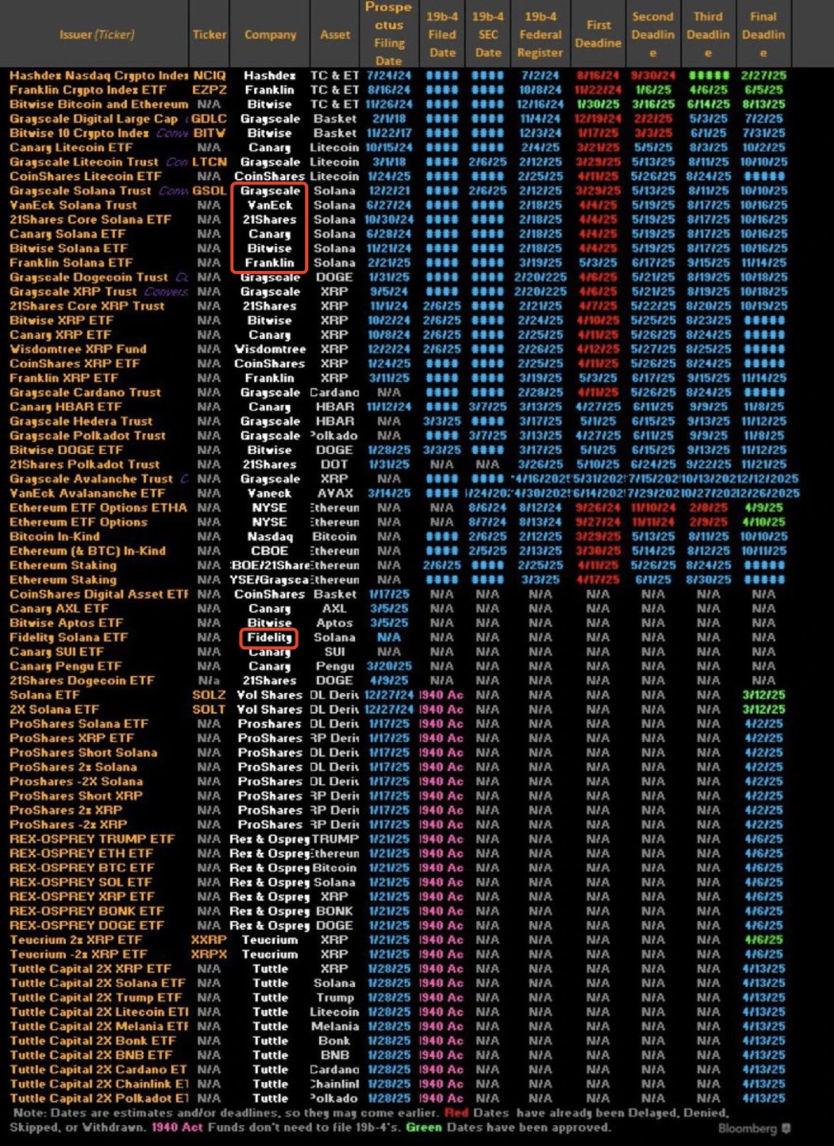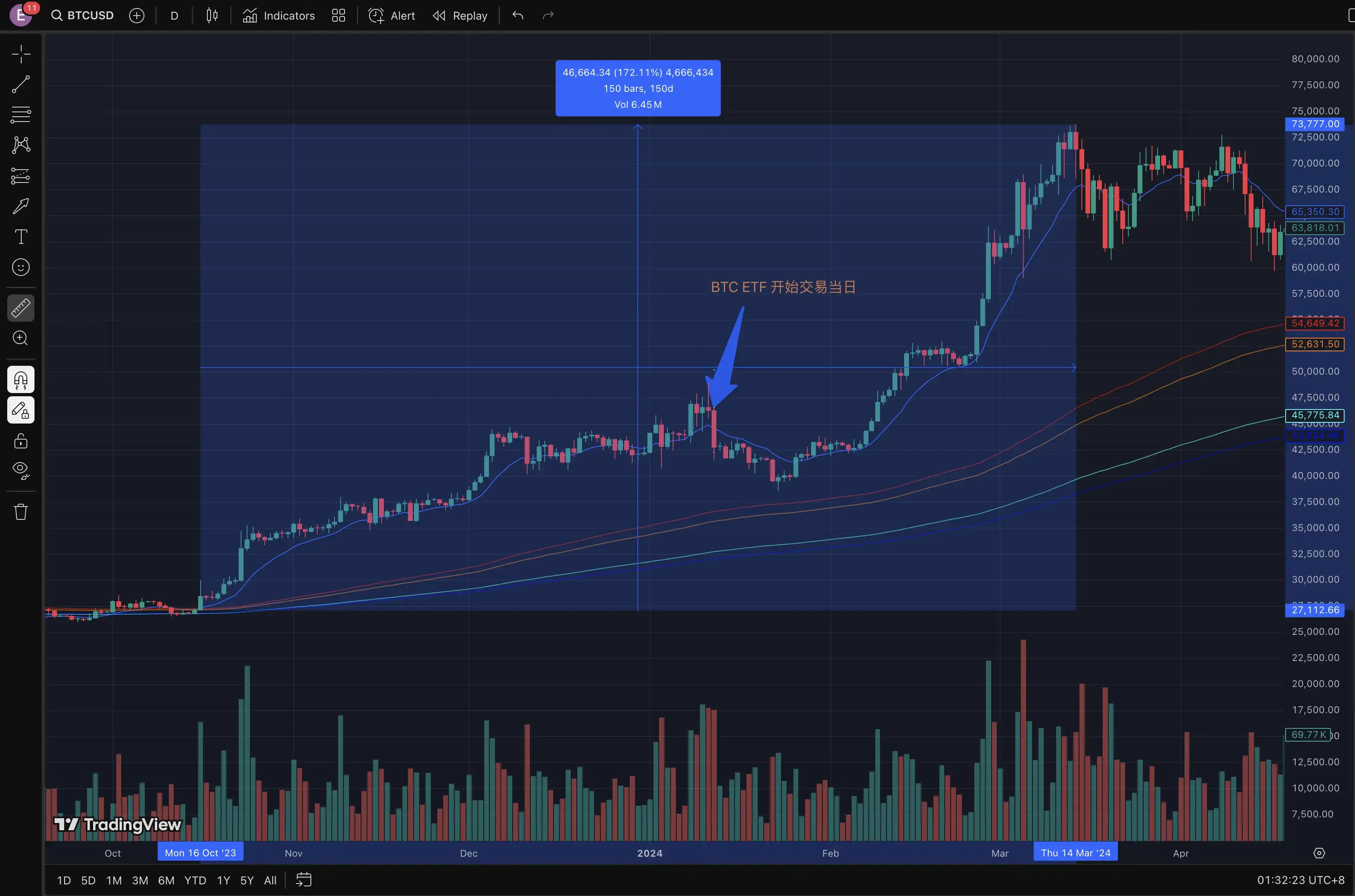Original Title: "Spot ETF Expected to Launch as Early as July, Can Solana Replicate BTC-style Surge?"
Original Author: Ethan, Odaily Planet Daily
On June 11, the U.S. Securities and Exchange Commission (SEC) notified several institutions planning to issue a Solana spot ETF, requesting them to resubmit revised S-1 documents within 7 days, focusing on wording corrections related to the "physical redemption mechanism" and "staking terms." This move is seen by the market as a clear signal of a shift in regulatory attitude, quickly igniting bullish sentiment, with SOL prices rising sharply, briefly breaking through $165, and experiencing a daily increase of up to 5%.
As market sentiment heats up, investors are betting that Solana may become the third cryptocurrency, after BTC and ETH, to be included in a mainstream financial spot ETF. With the ETF trading structure becoming clearer and regulatory signals warming, investors' focus has shifted from "whether it can pass" to "when it will pass" and "who will launch it."

Regulatory Trends: From Unimaginable to Gradually Acceptable, Solana Enters Review Countdown
The SEC's current focus is no longer on "whether to allow" the Solana spot ETF to launch, but rather on "how to compliantly express the ETF's staking and redemption structure." To understand why this S-1 revision is significant, we need to look back at the SEC's past statements regarding the ETH spot ETF.
On May 24, 2024, the Ethereum spot ETF was approved, primarily because the SEC ultimately abandoned its inquiry into whether ETH is a security, and the ETF structure explicitly excluded staking terms. This allowed the SEC to view it as a "commodity ETF," fitting it into traditional asset regulatory logic.
In contrast, Solana, as a highly PoS-dependent chain, has had its staking mechanism's compliance as a point of contention. The SEC's requirement for applicants to clarify staking mechanism details in the S-1 document is widely interpreted as "no longer avoiding staking," but rather attempting to incorporate PoS logic within the regulatory framework. Staking Rewards data shows that as of June 12, Solana's staking rate is 65.44%, with a staking yield of 7.56%, more than double that of ETH (3.13%).
More importantly, the SEC has also committed to completing review feedback within 30 days of the S-1 document submission. This is extremely rare in the review process for Bitcoin and Ethereum spot ETFs and indicates that the window for the Solana spot ETF has opened, with the possibility of approval as early as mid-July.
Approval Timeline Prediction: SOL ETF Could Pass as Early as July
According to reports from Blockworks, sources expect that after completing these S-1 document updates, the Solana ETF is likely to receive final approval within the next three to five weeks.
James Seyffart from Bloomberg Industry Research stated that he expects approval this year, possibly as early as July. In a report this week, Seyffart wrote, "We believe the SEC may now focus on processing Solana's 19 b-4 application and staking ETF earlier than planned. Issuers and industry participants may have been working with the SEC and its cryptocurrency working group to develop rules, but the agency's deadline for making decisions on such applications is not until October."
In April of this year, Bloomberg Industry Research analyst Eric Balchunas indicated that he has raised the probability of SOL ETF approval from 70% to 90%. In his latest tweet, he stated, "Get ready for a potential altcoin ETF summer; Solana may lead the way (along with some basket products)."

Additionally, political factors are quietly driving the regulatory shift: current U.S. President Trump has publicly supported the cryptocurrency industry; both houses of the U.S. Congress have passed resolutions to overturn SAB 121, legislatively negating accounting policies for crypto assets; and the FIT21 bill under congressional review explicitly proposes exemptions for decentralized digital assets from securities standards, suggesting that SOL may be above the compliance threshold.
Overall, the approval of the Solana spot ETF has moved from "unreachable" to a "clear path," indicating that it has officially entered the final stage of compliance negotiation.
Who is in Line? A Panorama of Solana ETF Issuers
The competition for the Solana ETF began with VanEck's submission of the S-1 document last year, followed closely by 21 Shares and Bitwise.
Currently, the institutions that have submitted Solana ETF applications include VanEck, 21 Shares, Grayscale, Bitwise, Canary Capital, Franklin Templeton, and Fidelity, all waiting for the SEC's final decision on their Solana ETF applications. Among them, Grayscale is planning to replicate its existing SOL trust product into a spot ETF due to its successful cases with BTC and ETH spot ETFs.

Image source: @Shibo
If the ETF is approved, Can SOL Take Off Like BTC?
Lessons from the BTC ETF:
Referring to the market reaction before and after the approval of the BTC spot ETF from late 2023 to early 2024: BTC started around $27,000 in October 2023, and on the day of its spot ETF trading and the following day (January 11 to 12, 2024), it briefly dropped 15%, subsequently accumulating a 21% decline, before surging to a peak of $73,000, an increase of nearly 2.7 times.

However, such "good wishes" did not materialize for ETH. After ETH confirmed its spot ETF in May, until the ETF opened for trading on July 23, the price response was muted, with an increase of less than 30%. A month after the ETF opened for trading, it plummeted over 30%.
While the approval of the ETF has positive implications for the long-term legitimacy of cryptocurrencies and institutional capital inflows, short-term price performance is influenced by market expectations and the "buy the expectation, sell the fact" mentality. Therefore, for ETH, the approval of its ETF may have validated previous market expectations rather than bringing new, unaccounted-for stimuli. Another reason is that ETH's ETF is a "stripped version," lacking a staking yield mechanism, which is not very attractive to users.
If SOL Passes the ETF, What is the Upside Potential?
According to GSR model estimates, if the inflow of funds into the SOL ETF is 5% of that of the BTC ETF, its price could increase by 3.4 times, rising from the current $160 to $500, potentially hitting the $400 – $500 range; in a more optimistic scenario, if the inflow reaches 14%, the price could exceed $800.
However, it is important to be cautious of the selling pressure risk for SOL. Early investors in SOL have very low costs, and the ETF launch could become a point for unlocking exits. Additionally, the supply structure of SOL differs from BTC and ETH: the staking proportion has exceeded 65%, and whether the ETF will allow staking of shares remains uncertain. If staking rewards are not included in the ETF structure, the SOL in the spot ETF will lose attractiveness due to not participating in on-chain returns. Furthermore, once the ETF becomes a mainstream funding channel, on-chain DEX and DeFi ecosystems may face liquidity migration risks.
Therefore, before and after the confirmation of ETF news, the market is likely to experience a "first speculate on expectations, then realize" volatility structure, which is very similar to the price cycle before and after the BTC ETF began trading.
Is SOL Worth a Heavy Investment?
From the current public information and market feedback, the Solana spot ETF is expected to receive formal approval within the next 2 to 3 weeks, becoming another "mainstream entry channel" after BTC and ETH. In the short term, SOL prices may be further driven by capital expectations, targeting the $200 – $300 range; in the medium term, whether it can replicate the BTC-style explosion depends on two variables:
Whether the ETF structure can solve the staking issue and truly achieve the dual goals of "on-chain returns + regulatory transparency";
Whether the on-chain ecosystem can accommodate the new traffic and trading demand, building a solid "capital + application" closed loop.
At the intersection of cryptocurrency assets moving towards compliance and mainstream finance, the Solana ETF is not just a product but a collective stress test for public chain competition, PoS consensus mechanisms, and DeFi applications.
免责声明:本文章仅代表作者个人观点,不代表本平台的立场和观点。本文章仅供信息分享,不构成对任何人的任何投资建议。用户与作者之间的任何争议,与本平台无关。如网页中刊载的文章或图片涉及侵权,请提供相关的权利证明和身份证明发送邮件到support@aicoin.com,本平台相关工作人员将会进行核查。




